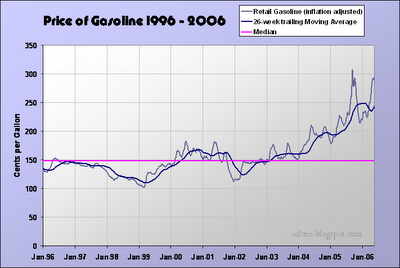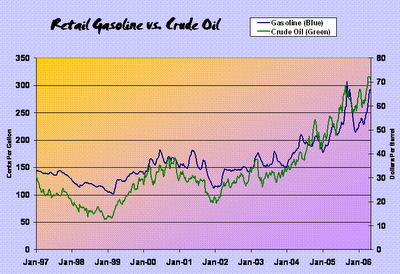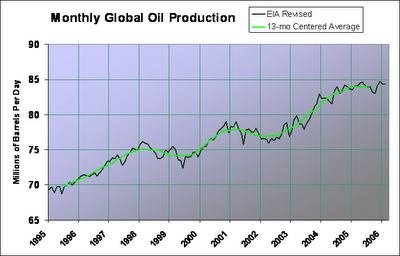Oil Consumption and GDP 1970 - 2006

OK, the numbers are in. There is nothing new here - and no surprises. This a chart I had done before, but too quickly with rough numbers. I took the opportunity of a reader's suggestions to revisit the work and analysis.
First, I still want to work on the graph design, since the Green Line is redundant, and many of the labels are blurred or unclear. But let's talk about that. This graph covers alot of years. 36. A third of a century. I always like to get the long view on stuff, but it is very difficult feeling confident about the seamlessness and reliablity of your data over so long a period. Remember, I use the Nymex price for oil, and they only started trading in 1983. So where did I get the data before that? You will have to trust me for now. I can't decipher my own notes on the numbers. I use an acronym - IRAC - which I can't for the life of me remember what I meant by it. The good news is that the numbers match all other published oil-price data for the time period, I'll be posting a graph soon demonstarting that.
There is a simple formula behind these numbers. (Nominal Price per barrel x number of barrels per day) / Nominal GDP for quarter. I have calculated this on a monthly basis by using the quarterly GDP number for each of the months in the quarter.
I manipulate these numbers to get as smooth and as descriptive an image as possible. I'm using 13-month centered moving averages on barrels-per-day and GDP. I'm using a trailing 6-month average on the price. My method is simple. I looked at several variations - and this looks better. Certain people will have a problem with that, and they may be right, for certain reasons. Me, I'm looking for bigger, long-term trends. I'm looking for lessons and conclusions. I'm looking for that in images.
The Green Line is the inflation-adjusted price of oil, using, what I believe is a CPI-based inflation adjuster. I threw it in for the very reason that I knew I had produced the data probably two years earlier and that the derivation method was most certainly different. Remember, the variables used for the Blue Line(percentage of GDP) are all nominal, non-inflation-adjusted. The fact that the two lines nicely mirror each other serves to somewhat verify that you must be doing something right. Keep in mind, these are two different sets of data plotted against two different axes.
I've already written too much. More soon...






